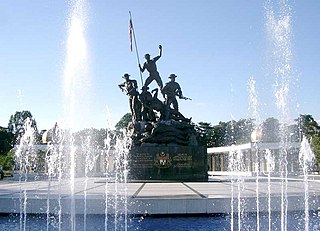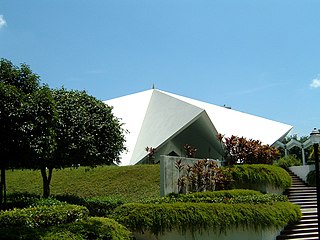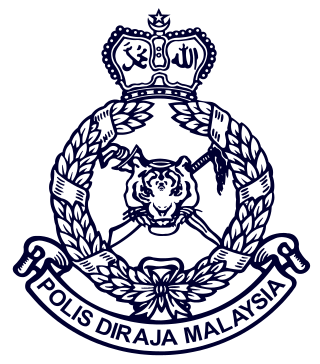
The Parliament of Malaysia is the national legislature of Malaysia, based on the Westminster system. The bicameral parliament consists of the Dewan Rakyat and the Dewan Negara. The Yang di-Pertuan Agong (King), as the head of state, is the third component of Parliament.

Sultan Sir Ismail Nasiruddin Shah ibni Almarhum Sultan Haji Zainal Abidin III Mu’azzam Shah was Sultan of Terengganu from 1945 until his death in 1979, and the fourth Yang di-Pertuan Agong, the constitutional monarch of Malaysia, from 1965 to 1970.

The National Mosque of Malaysia is a mosque in Kuala Lumpur, Malaysia. It has a capacity for 15,000 people and is situated among 13 acres (53,000 m2) of gardens. Its key features are a 73-metre-high (240 ft) minaret and a 16-pointed star concrete main roof. The umbrella, synonymous with the tropics, is featured conspicuously – the main roof is reminiscent of an open umbrella, the minaret's cap a folded one. The folded plates of the concrete main roof are a creative solution to achieving the larger spans required in the main gathering hall. Reflecting pools and fountains are spread throughout the compound. Completed in 1965, the mosque is a bold and modern approach in reinforced concrete, symbolic of the aspirations of a then newly independent nation.

The Royal Museum along Jalan Istana was the former National Palace and former residence of the Yang di-Pertuan Agong of Malaysia. It stands on a 13-acre (50,000 m2) site, located on a commanding position on the slope of a hill of Bukit Petaling overlooking the Klang River, along Jalan Syed Putra.

The Malaysian Houses of Parliament, is a complex where the Malaysian Parliament assembles. The structure is located at the Perdana Botanical Gardens in Kuala Lumpur, close to the Malaysian National Monument.
Mohamed Noah bin Omar was a Malaysian politician. He was one of the leading figures who founded the United Malays National Organisation (UMNO) and became the party’s first chairperson. He also served the first Speaker of the Dewan Rakyat.

This article lists important figures and events in Malayan and Malaysian public affairs during the year 1963, together with births and deaths of significant Malaysians. The Federation of Malaya merged with Singapore, North Borneo, and Sarawak to form the Federation of Malaysia on 16 September.

This article lists important figures and events in Malaysian public affairs during the year 1990, together with births and deaths of notable Malaysians.

This article lists important figures and events in Malaysian public affairs during the year 1966, together with births and deaths of significant Malaysians.

This article lists important figures and events in Malaysian public affairs during the year 1973, together with births and deaths of notable Malaysians.
This article lists important figures and events in Malaysian public affairs during the year 1975, together with births and deaths of notable Malaysians.
This article lists important figures and events in Malaysian public affairs during the year 1992, together with births and deaths of notable Malaysians.

Ungku Abdul Aziz bin Ungku Abdul Hamid was a Malaysian economist and lecturer. He was the 3rd Vice-Chancellor of the University of Malaya from 1968 to 1988 and the 1st General Director of the Council on Language and Literature of Malaysia from 1956 until 1957. He was awarded the title of Royal Professor in 1978.

The Istana Negara is the official residence of the Yang di-Pertuan Agong, the monarch of Malaysia. It is located along Jalan Tuanku Abdul Halim near Taman Duta, northwestern Kuala Lumpur. The palace opened in 2011 and replaced the old Istana Negara which was located at a different compound in central Kuala Lumpur.

2011 in Malaysia is the 54th anniversary of Malaysia's independence.
Dato’ Seri Nik Mohamed bin Nik Mahmood is a Director of Kumpulan Senireka Sdn Bhd., a large commercial architecture firm in Kuala Lumpur, Malaysia. Mahmood founded the firm in 1973 after he left the Public Works Department. The firm specializes in commercial highrise buildings, and they have done some significant religious buildings. In the 1970s they were operating in the Brutalist idiom, but they turned to Postmodernism at the end of the century and were responsible for some prominent postmodern buildings in Malaysia, including the Menara Axis, 2002, Istana Negara Baru and the Kompleks Dewan Bahasa & Pustaka.

Jalan Tuanku Abdul Halim, formerly known as Jalan Duta, is a major highway in Kuala Lumpur, Malaysia. It connects Segambut to the Parliament interchange on the Kuala Lumpur Middle Ring Road 1. It was named after the fifth and fourteenth Yang di-Pertuan Agong, Tuanku Abdul Halim Muadzam Shah of Kedah.

The Inspector-General of Police, also known as the Chief of Police, is the highest-ranking police officer of the Royal Malaysia Police. He was assisted by the Deputy Inspector-General of Police or Deputy Police Inspector-General (DPIG), he reports to the Minister of Home Affairs. The IGP is based at Bukit Aman, Kuala Lumpur which is the Headquarters of the RMP.
Mohammad bin Ab Rahman is a Malaysian military officer who currently serves as the 22nd Chief of Defence Forces since September 2023. Prior to his appointment, he previously served as the Chief of Army from March 2023 to September 2023.
















